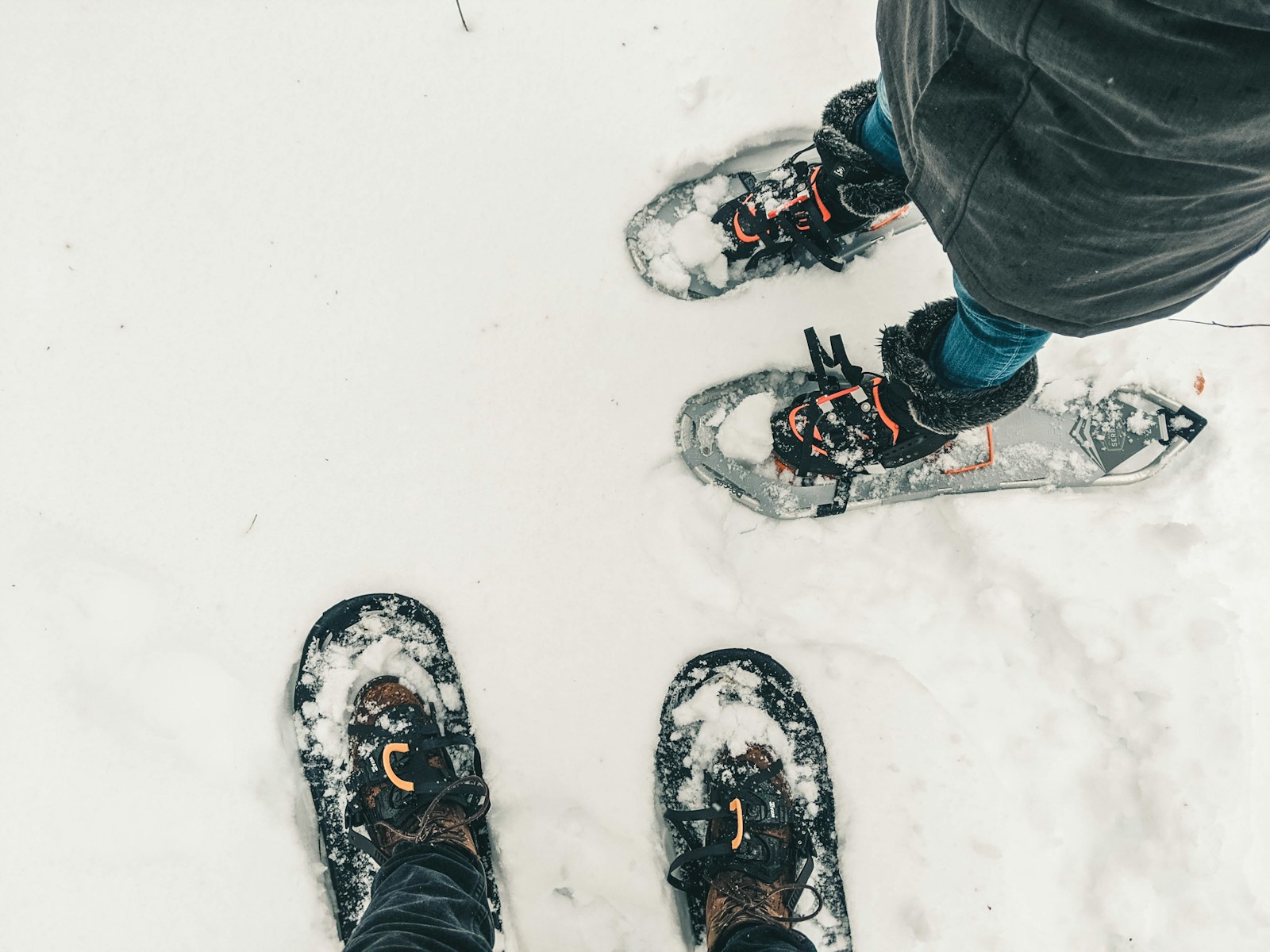Snowshoeing is not just a winter activity; it is a full-body workout that brings along numerous health benefits. From cardiovascular fitness to mental well-being, regular snowshoeing is a fantastic way to stay active during the colder months. Let’s delve into 20 benefits of regular snowshoeing for winter fitness and exploration.
Full-Body Workout
Snowshoeing stands out as a holistic fitness activity that challenges nearly every major muscle group in the body. The resistance offered by the snow adds intensity to the workout, particularly targeting the lower body muscles like the glutes, hamstrings, and quadriceps. This resistance forces these muscles to work harder than they would on solid ground, promoting muscle strength and endurance. Moreover, the action of lifting your feet with the added weight of snowshoes engages your core muscles, enhancing core strength and stability. The use of poles introduces an upper body component, activating the arms, shoulders, and back muscles. This integration of upper and lower body workout ensures a balanced exercise routine that can improve muscle tone, boost cardiovascular fitness, and increase calorie burn, making snowshoeing an effective and comprehensive full-body workout.
Cardiovascular Health
Snowshoeing is an excellent cardiovascular exercise that significantly contributes to heart health. The activity increases the heart rate, similar to jogging or brisk walking, but with added resistance from the snow. This elevated heart rate during snowshoeing enhances cardiovascular endurance, improving the efficiency of the heart and lungs. Over time, regular engagement in this activity can lead to a stronger heart, reduced blood pressure, and a decreased risk of cardiovascular diseases. The rhythmic nature of snowshoeing also promotes better blood circulation, ensuring that oxygen and nutrients are efficiently distributed throughout the body, supporting overall health and wellness.
Burn Calories
The caloric expenditure in snowshoeing is notably higher than many other forms of exercise due to the additional effort required to move through the snow. This activity combines the benefits of aerobic exercise with the resistance provided by snow, leading to significant calorie burn. The intensity of the workout and the energy required to navigate through varying depths and types of snow contribute to a higher metabolic rate both during and after the activity. This makes snowshoeing an excellent choice for those looking to manage their weight, burn fat, and improve their metabolic health. Whether you’re trekking up a hill or moving across flat terrain, the constant push-pull action against the snow ensures that your body is burning calories efficiently throughout the workout.
Low Impact Exercise
Unlike many high-impact activities that can be harsh on the joints, snowshoeing offers a low-impact alternative that is gentle on the body. The snow acts as a cushion, absorbing much of the impact with each step, reducing the stress on knees, hips, and ankle joints. This makes it an ideal exercise option for people with arthritis, knee problems, or those recovering from injury. Furthermore, the controlled, steady movements involved in snowshoeing help to strengthen the muscles around the joints, providing additional support and reducing the risk of joint injuries. By offering a balance between effective exercise and joint protection, snowshoeing is a sustainable and enjoyable fitness activity for individuals at all fitness levels and ages.
Strengthens Muscles
Snowshoeing is an effective way to build and tone muscles, particularly in the lower body. The act of walking through snow requires greater effort than walking on a hard surface, leading to increased muscle engagement and strength development. The resistance of the snow forces the muscles to adapt and strengthen, which can lead to improvements in muscle tone, endurance, and overall physical strength. This muscle strengthening extends beyond the legs and glutes, as the use of poles engages the upper body, including the arms, shoulders, and core, providing a balanced muscle workout. Additionally, the varied terrain and changing snow conditions can introduce different challenges, further promoting muscle strength and adaptability.
Vitamin D Absorption
Snowshoeing outdoors during daylight hours provides exposure to natural sunlight, which is essential for the body to produce Vitamin D. This vitamin plays a crucial role in bone health, immune function, and mood regulation. Many individuals experience reduced sun exposure during the winter months, which can lead to lower levels of Vitamin D. Engaging in outdoor activities like snowshoeing can help counteract this by providing a natural source of sunlight, contributing to improved Vitamin D synthesis, supporting overall health and well-being.
Mental Wellness
The serene and natural settings often associated with snowshoeing offer a peaceful escape from the daily grind, providing a sense of tranquility and mental clarity. The natural beauty of the snow-covered landscapes can have a calming effect, reducing stress and anxiety levels. This connection with nature, combined with the physical exercise of snowshoeing, releases endorphins, the body’s natural mood lifters, which can alleviate symptoms of depression and enhance overall mental wellness. The quiet and contemplative environment allows for a form of moving meditation, where one can practice mindfulness, focusing on the present moment and the physical sensations of moving through the snow, promoting a sense of inner peace and mental balance.
Enhances Endurance
Regular snowshoeing can lead to improved endurance and stamina. The activity challenges the cardiovascular system and muscles, requiring them to work efficiently over extended periods. As you snowshoe, your body adapts to the demands of sustained physical effort, enhancing your ability to perform not only this activity but others as well, for longer durations without excessive fatigue. This improvement in endurance is beneficial for overall health and can positively impact other areas of life, such as increasing productivity in daily tasks and improving the ability to engage in various physical activities. Moreover, as your endurance builds, you may find that you can snowshoe for longer distances or tackle more challenging terrain, further boosting your cardiovascular and muscular endurance. This cycle of improvement can lead to significant gains in physical fitness, making snowshoeing an excellent choice for those looking to enhance their endurance in a natural and enjoyable way.
Improved Balance and Coordination
The uneven and shifting terrain encountered during snowshoeing requires continuous adjustments in balance and coordination. Each step may involve adapting to changes in the snow’s depth and consistency, which engages and strengthens the core and stabilizer muscles. Improving these skills is vital for overall mobility and can reduce the risk of falls and injuries. The benefits of enhanced balance and coordination extend beyond snowshoeing, improving performance in other sports and daily activities. Regularly practicing this activity can lead to better proprioception—your body’s ability to sense movement, action, and location—enhancing your overall physical coordination and agility.
Fresh Air and Oxygen Intake
Engaging in outdoor activities like snowshoeing provides an excellent opportunity to breathe in fresh, clean air, particularly in natural settings away from urban pollution. The cold, crisp air in winter environments can be particularly invigorating, helping to clear the mind and rejuvenate the body. Increased oxygen intake during vigorous exercise improves cellular function and energy production. This enhanced oxygenation can boost brain function, improve concentration, and increase energy levels, contributing to a sense of vitality and well-being.
Social Connection
Participating in snowshoeing with others can create meaningful social interactions and strengthen bonds with friends and family. Group activities in nature often lead to shared experiences that can enhance relationships and provide a sense of community and belonging. These social connections are vital for emotional health and can contribute to a greater sense of happiness and fulfillment. Whether it’s enjoying the quiet beauty of a snowy landscape together or sharing the excitement of exploring new trails, snowshoeing offers a unique setting for building and nurturing social ties.
Immune System Boost
Regular moderate exercise like snowshoeing is known to have a positive impact on the immune system. Physical activity can help flush bacteria out of the lungs and airways, reduce the chance of catching colds or the flu, and stimulate changes in antibodies and white blood cells, making the immune system more vigilant. Additionally, the reduction in stress hormones, which can inhibit the immune system, further enhances the body’s ability to fight off infections. Thus, snowshoeing can be a fun and effective way to support your body’s immune defenses.
Weight Management
Snowshoeing is an efficient calorie-burning exercise that can play a significant role in weight management and body composition. The combination of cardiovascular exercise and resistance training helps burn calories and fat, while building muscle mass. This dual benefit makes snowshoeing an excellent choice for those looking to manage their weight or improve their body composition. The activity’s adaptability allows for variations in intensity, making it suitable for a wide range of fitness levels and weight management goals.
Nature Connection
Immersing yourself in the natural environment while snowshoeing can foster a deep connection with nature, offering psychological and emotional benefits. This connection can lead to increased appreciation for the environment, promoting environmental stewardship and sustainability. The calming effect of natural landscapes can also reduce stress and enhance mood, contributing to overall mental health and well-being.
Mindfulness Practice
The act of snowshoeing can serve as a form of mindfulness, where one can focus on the present moment, the rhythm of their steps, and the natural surroundings. This practice can reduce stress, anxiety, and negative thought patterns, promoting a sense of calm and mental clarity. Mindfulness during snowshoeing can enhance the experience, making it not only a physical workout but also a mental and emotional one, fostering a holistic sense of health and well-being.
Bone Health
Weight-bearing exercises like snowshoeing are beneficial for bone health, as they promote bone density and reduce the risk of osteoporosis. The activity’s impact forces stimulate bone-forming cells, encouraging the development of stronger bones. This benefit is particularly important for older adults and postmenopausal women, who are at higher risk for bone density loss. Regular participation in snowshoeing can contribute to a robust skeletal structure, supporting overall health and mobility.




